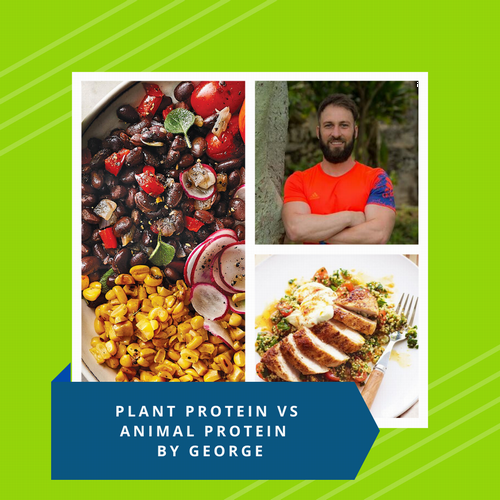Plant Protein Vs Animal Protein

Proteins are complex organic compounds. Protein is an important part of eating profiles due to its role of repairing tissue after bouts of physical activity. The basic structure of protein is a chain of amino acids. They provide energy for the body. Protein is an important component of every cell in the body. Hair and nails are mostly made of protein. Your body uses protein to build and repair tissues. You also use protein to make enzymes, hormones, and other body chemicals. Protein is an important building block of bones, muscles, cartilage, skin, and blood.
Along with fat and carbohydrates, protein is a "macronutrient," meaning that the body needs relatively large amounts of it. In many popular low-carbohydrate diets, protein requirements increase when calories are insufficient from other macronutrients. If carbohydrates are cut from the diet, the difference needs to come from one of the other macronutrients. Since fat is not an ideal choice, the only other option is protein. Protein is an important source of energy for the body when carbohydrates and fats are not available.
Protein Sources: Plants and Animal
Traditionally, meat has been thought of as our main source of protein, but there are plenty of diverse protein sources out there. Animal protein and plant protein seem to have the same effect on health. Is the type of protein likely to make a difference? Unlike animal proteins, plant proteins may not contain all the essential amino acids. However, a varied vegetarian diet means a mixture of proteins are consumed so that both essential and non-essential amino acids are consumed daily.
Animal Protein
Found in meat, fish, eggs, dairy
The human body needs 20 different amino acids. Our bodies can make 11 of them (these are called non-essential amino acids), but we must get the other 9 from our diet (essential amino acids). Animal proteins are considered complete proteins, meaning, they provide all essential amino acids that our body needs. Animal products provide the highest quality protein sources.
List of Animal High-Protein Foods and Amount of Protein in Each:
Beef
•Hamburger patty, 4 oz – 28 grams
•Steak, 6 oz – 42 grams
•Most cuts of beef – 7 grams per ounce
Chicken
•Chicken breast, 3.5 oz - 30 grams
•Chicken thigh – 10 grams (for average size)
•Drumstick – 11 grams
•Wing – 6 grams
•Chicken meat, cooked, 4 oz – 35 grams
Fish
•Most fish fillets or steaks have about 22 grams of protein for 3.5 oz (100 grams) of cooked fish, or 6 grams per ounce
•Tuna, 6 oz can - 40 grams
Pork
•Pork chop, average - 22 grams
•Pork loin or tenderloin, 4 oz – 29 grams
•Ham, 3 oz serving – 19 grams
•Ground pork, 1 oz raw – 5 grams; 3 oz cooked – 22 grams
•Bacon, 1 slice – 3 grams
•Canadian-style bacon (back bacon), slice – 5-6 grams
Eggs and Dairy
•Egg, large - 6 grams
•Milk, 1 cup - 8 grams
•Cottage cheese, ½ cup - 15 grams
•Yogurt, 1 cup – usually 8-12 grams, check label
•Soft cheeses (Mozzarella, Brie, Camembert) – 6 grams per oz
•Medium cheeses (Cheddar, Swiss) – 7 or 8 grams per oz
•Hard cheeses (Parmesan) – 10 grams per oz
Plant Protein (including soy)
Found in beans, legumes, nuts, seeds, quinoa, broccoli, kale, edamame, miso, soy sauce, tofu.
Certain plants can be excellent sources of protein, often with fewer calories and fewer potentially harmful effects than animal products. Some plant proteins, such as quinoa, are considered complete proteins, meaning they contain all 9 essential amino acids that we need. Others are missing some amino acids, so it is important to have a variety of foods to get all 9 essential amino acids.
Studies show that people on vegetarian or vegan diets are at lower risk of certain diseases including some cancers, type 2 diabetes, hypertension, obesity and ischemic heart disease.
Soy protein is found in soybeans, a legume that does not contain cholesterol and is low in saturated fat. Soybeans are one of the only vegetable foods that contain all 9 essential amino acids. They are also a good source of fiber, iron, zinc, and B vitamins. Eating soy protein in place of animal protein has been found to reduce bad cholesterol and triglycerides, which are linked to heart disease. Some studies show that soy contributes to blood sugar control and reduced body weight
List of Plant High-Protein Foods and Amount of Protein in Each:
Beans (including soy)
•Tofu, ½ cup - 20 grams
•Tofu, 1 oz - 2.3 grams
•Soy milk, 1 cup – 6-10 grams
•Most beans (black, pinto, lentils, etc.) about 7-10 grams of protein per 1/2 cup of cooked beans
•Soybeans, ½ cup cooked – 14 grams
•Split peas, ½ cup cooked – 8 grams
Nuts and Seeds
•Peanut butter, 2 Tablespoons - 8 grams
Almonds, ¼ cup – 8 grams
•Peanuts, ¼ cup – 9 grams
•Cashews, ¼ cup – 5 grams
•Pecans, ¼ cup – 2.5 grams
•Sunflower seeds, ¼ cup – 6 grams
•Pumpkin seeds, ¼ cup – 8 grams
•Flax seeds, ¼ cup – 8 grams
Recommendations
It is recommended that 10–35% of your daily calories come from proteins.
Protein Gram Requirements
Sedentary adults: 0.4g / lbs of bodyweight or 0.8g / kg of bodyweight
Recreational athletes: 0.5 - 0.6 g / lbs of bodyweight or 0.8 - 1.3g / kg of bodyweight
Adult endurance athletes: 0.6 - 0.7g / lbs of bodyweight or 1.2 - 1.5g / kg of bodyweight
Adult strength trained athletes: 0.7 - 0.8g / lbs of bodyweight or 1.5 - 1.7g / kg of bodyweight